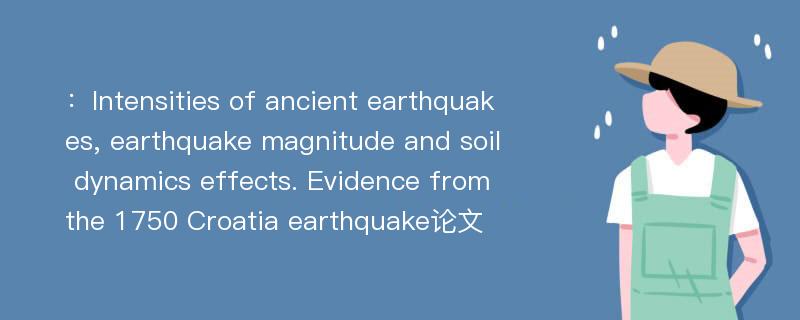
本文主要研究内容
作者(2019)在《Intensities of ancient earthquakes, earthquake magnitude and soil dynamics effects. Evidence from the 1750 Croatia earthquake》一文中研究指出:A problem in the study of pre-instrumental earthquakes is how to reconstruct their parameters based on usually fragmentary evidence of seismic intensities, which reflect the combined effect of fault dynamics,of radiation of seismic waves, and of local amplification or attenuation of strong seismic motions. This problem is highlighted in the 1750 earthquake in Croatia, in the active compressional margin of NW Adriatic, an area with rarely known seismic history. Recent high-quality historical and archaeological data revealed that the 1750 earthquake was associated with high(up to VIII) seismic intensities, which were assigned to local amplification of strong motion generated by a magnitude 5 earthquake. This scenario points to a nearly aseismic plate boundary and to an unusually long meizoseismal zone for a small earthquake. On the contrary, in this study, the 1750 earthquake is associated with a segment of a major thrust and with a M > 6.0 earthquake which produced moderate accelerations. These results were based on a triple correlation between(1) a Finite Fault Model derived from elastic dislocation analysis of differential subsidence of submerged coastal notches,(2) a major composite thrust and(3) the distribution of areas of high seismic intensities. This result provides some input for the estimation of the seismic hazard/risk in the study area, indicates that the Adria-Eurasia collision front in NW Croatia is not essentially aseismic, and highlights the need to include soil dynamics effects in the study of palaeoseismic events.
Abstract
A problem in the study of pre-instrumental earthquakes is how to reconstruct their parameters based on usually fragmentary evidence of seismic intensities, which reflect the combined effect of fault dynamics,of radiation of seismic waves, and of local amplification or attenuation of strong seismic motions. This problem is highlighted in the 1750 earthquake in Croatia, in the active compressional margin of NW Adriatic, an area with rarely known seismic history. Recent high-quality historical and archaeological data revealed that the 1750 earthquake was associated with high(up to VIII) seismic intensities, which were assigned to local amplification of strong motion generated by a magnitude 5 earthquake. This scenario points to a nearly aseismic plate boundary and to an unusually long meizoseismal zone for a small earthquake. On the contrary, in this study, the 1750 earthquake is associated with a segment of a major thrust and with a M > 6.0 earthquake which produced moderate accelerations. These results were based on a triple correlation between(1) a Finite Fault Model derived from elastic dislocation analysis of differential subsidence of submerged coastal notches,(2) a major composite thrust and(3) the distribution of areas of high seismic intensities. This result provides some input for the estimation of the seismic hazard/risk in the study area, indicates that the Adria-Eurasia collision front in NW Croatia is not essentially aseismic, and highlights the need to include soil dynamics effects in the study of palaeoseismic events.
论文参考文献
论文详细介绍
论文作者分别是来自Geodesy and Geodynamics的,发表于刊物Geodesy and Geodynamics2019年04期论文,是一篇关于,Geodesy and Geodynamics2019年04期论文的文章。本文可供学术参考使用,各位学者可以免费参考阅读下载,文章观点不代表本站观点,资料来自Geodesy and Geodynamics2019年04期论文网站,若本站收录的文献无意侵犯了您的著作版权,请联系我们删除。
